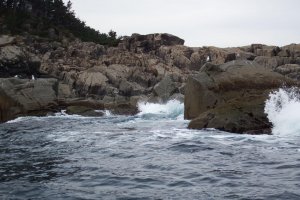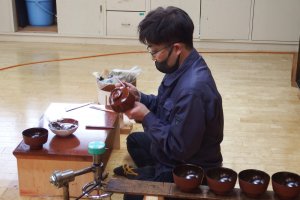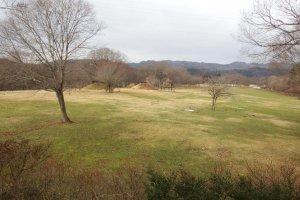What is Iwate’s greatest charm? That was the question I posed to our Okami-san (Japanese-inn manager) on the first night. Her answer? Its people. Iwate people, she explained, are brought up in the cold climate of the north and can seem quiet or even rough to outsiders—but just below the surface were people warmer than any others, ready to help each other (and feed each other near to bursting).
At first, I thought it was a simple answer, but as I kept my eyes open the next three days exploring Iwate I learned that the same could be said for the land, the culture, and its people.
Quiet yet warm. That’s what any visitor can expect of Iwate Prefecture.
Unfortunately, Iwate is sometimes overlooked by visitors in Japan. Most first-timers will stay in Osaka, Kyoto, or Tokyo, and return travelers pass over Iwate for flights to Okinawa or Hokkaido. There’s no doubt that those destinations can be more convenient—however, a trip to Iwate will show you a side of the culture and people rarely seen at “hot” travel destinations. Iwate is authentic Japanese people living their lives and inviting you to become a part of the experience.
Culture
A visit to Iwate is filled with Japanese culture steeped in a rich history. From early establishments of Jomon-period people to local tales of yokai (Japanese spirits) and even handmade crafts using local products, Iwate culture is both fascinating and immersive.

Zashiki Warashi
Perhaps one of Iwate’s most well-known local yokai, the zashiki warashi is a childlike house-protecting and prosperity-bringing spirit. There are many iterations of the zashiki warashi (parlor child in English); almost always depicted wearing a yukata and bob cut, the zashiki warashi brings good fortune to any who spots it. However, a red-skinned zashiki warashi is a sign that the home will fall to ruin or even a portent of death.
Want to have a close encounter? Ryokan around the Kindaichi Onsen Village are ripe with zashiki warashi claims and promises of a spooky night in a house filled with child spirits. Try putting out some azuki-bean snacks, the reputed favorite of zashiki warashi.

Let’s just say that in my experience, it worked. A little too well.
Jomon Goshono Museum and Village
While the Jomon period lasted from 14,000 to 300 BCE, the vestiges of the culture and many settlements can still be experienced across Tohoku and in other parts of Japan. The Jomon people are perhaps most famed for their alien-like clay figures and the sod-covered homes they made.

At Goshono Museum, you can see many artifacts of the past, including clay pots, dolls, and arrowheads. You can even experience a craft workshop on the 2nd floor of the museum, make your own ocarina, magatama (comma-shaped stone bead), or weave a basket.
Outside at the Goshono Village, experience authentic sod houses left behind by the Jomon people that feels a little like going into a hobbit’s hole. The mound-shaped homes evoke a sense of wonder and nostalgia for an age of long ago. Imagine the lives of these pioneers of early settled life.

Lacquerware at Joboji Urushi
Three to six months. That’s how long it takes to make a single piece of lacquerware. Urushi, or lacquer, is harvested in Iwate using an ancient technique; scraping bark off the side of a tree, then scoring the trunk, and finally scooping away the lacquer that drips forth.
The wooden product itself is selected from extremely lightweight woods—tochi (Japanese horse-chestnut) and mizume (Japanese cherry birch) are the most common; this gives the finished lacquerware a light yet sturdy feeling. And even when filled with hot liquid, the exterior remains only warm thanks to the low heat transferability of wood.

Before being painted, the urushi must be cured and temperature-controlled, then mixed with red earth and iron sand to create the vibrant red and black paints that are beloved by lacquerware enthusiasts. This finished urushi is meticulously painted on woodenware, dried, reshaped, and painted again a total of six times.
Prolonged usage of lacquerware actually makes it more stunning. The lacquer becomes more and more polished over time and gives the piece a glossy appearance. Each piece of lacquerware is a piece of Iwate culture and art.

Activities
With plenty of winter sports to try, any ski fanatic would be happy here. For the craft-lovers out there, Iwate has you covered too. Discover unique products, industries, and natural beauty. Iwate has this and more to offer the curious wanderer.

Woodworking at Ohno Campus
Ohno Campus at Michi no Eki Ohno, is host to a woodshop where guests have the privilege of trying their hand at making something from Iwate-grown wood. The aforementioned tochi and mizume are popular timber.

Under the guidance of an instructor, craft your own pair of chopsticks, toy helicopter propellor, or wooden keychain. The chopsticks experience had us choose out a pair of base chopsticks from the wood of our choice, sandpapering the edges and smoothing the shape, then woodburning and filing designs onto the chopstick handles—for more advanced students, there is also woodshop machinery that can be used under instructor guidance. Finally, polish your piece of art with walnut oil and package it for safekeeping.

Near the workshop, you’ll find a wood shop with hundreds of finished art pieces and usable handiwork. It was rewarding to create my own chopsticks and then see what the master woodworkers were capable of. Be sure to try the soba next door too!
Nodatamagawa Cave and Winery Walk
This last experience is for any adventurous sommelier visiting Iwate. Nodatamagawa Cave once mined manganese and rhodonite deposits. These days, however, the miner tunnels serve a different purpose. Imagine bottles and bottles of wine, large casks aging in the cold caves until they ferment into the perfect flavor profile. Meet Marine Rouge wine.
Before we get into the wine-side of things though, let’s talk damp, cold caves and—boy bands? Mangan Boyz is a visitor-voted boy band made up of mannequins depicting mining work inside the caves. It’s a rather silly thing to see how many votes each mannequin boy has racked up and with the roster changing every so often, it keeps the boys lively—well, as lively as they can be. Also on display are precious gems and stones that have been found all over the country and inside the mines there.

But, as the owner notes, most people visit for the wine. And not just because it’s fermented unusually in underground caves. The wine attracts people who are tired of “normal” wines, the wine of Nodatamagawa Marine Rouge is made entirely, 100%, with yama budo (wild mountain grapes). The wild grapes have a more sour taste than their supermarket counterparts and lend a depth to the wine’s palette that isn’t found anywhere else.

Cuisine
While every area in Japan boasts its own “local specialty” ramen or soba noodles, why not try something a little more unique? Iwate is no stranger to the staples of Japanese cuisine, but for a real experience of culinary delight, try these authentic specialties.

Hittsumi nabe
Hittsumi in local dialect means something akin to pinch or twist. So, that plus nabe, which means hotpot, and you get “pinching hotpot”? Well, that doesn’t explain what hittsumi nabe is at all.
Imagine ravioli-shaped pieces of thick dough, like an udon-noodle dumpling; those are the things you should be pinching apart with your chopsticks as you eat this warming hotpot dish. Other ingredients in this local dish include chicken, carrots, burdock, shiitake mushrooms, and whatever else happens to be in season.

It’s a great way to warm up on those cold Iwate days and the hittsumi dough is very filling. Nothing can quite compete with the winter chill like hittsumi nabe and it’s easy to see why it’s such a beloved meal.
Japanese Shorthorn yakiniku
Who doesn’t love beef yakiniku? Except for maybe vegetarians (apologies for the lack of vegetarian options in yakiniku)—that aside, Iwate yakiniku is something of a different love song to everyone’s favorite grilled meat meal. Many of the yakiniku restaurants in Iwate serve up cuts of Japanese shorthorn cattle.
The meat here is less marbled than that of Japanese Black, which may lead some to believe it’s of inferior quality. However, one taste and you’ll feel the difference in texture and taste. The oils and tenderness combine to create mouth-melting goodness.

When you order a plate of beef cuts to grill, I also recommend eating sanchu—pieces of lettuce and Korean paste wrapped around each piece of yakiniku. The green flavor of the lettuce and mild spice mix to create a deep flavor profile that you don’t get when you eat the meat separately.
Accommodation
It goes without saying that there’s just too much to see in Iwate. It simply cannot all be seen, experienced, or eaten in one day. Thus, we must find a place to stay. There’s no better experience than staying at a ryokan or traditional Japanese inn.

The Kindaichi Onsen Village area is replete with hot springs, much as its name suggests, and what’s better—you can go onsen hopping from ryokan to ryokan for a small fee paid at each establishment. Many ryokan in this area are even famed for their zashiki warashi. So how about it? Will you be brave enough to spend a night with the spirits?
Senyoukan Ryokan
Senyoukan Ryokan has a long history with zashiki warashi. So much in fact, that it’s rumored five of the yokai live within the premises. These zashiki warashi are said to take on the appearance of orbs of light.
Everything about the ryokan seems to be there in order to please the zashiki warashi. Bookshelves of manga, children’s toys, and stuffed animals seem to cover every corner. And while the Okami-san here seems quiet, she has just as much of that Iwate quiet-but-warm charm as Obonai’s Momoko-san.

Obonai Ryokan
Obonai is located off the main road running through Kindaichi Onsen Village, but it’s like a hidden gem once you enter the aged entrance. Though Obonai doesn’t outright boast any zashiki warashi on the premises, this writer knows a ghostly encounter when she feels one. Even after laying out azuki wafers and entreating with any would-be yokai, that night there was most definitely something in my room.

Spooks aside, the rustic interior of Obonai combined with the delightful onsen, service, and food (dishes upon dishes of food) all make Obonai one of the most friendly and welcoming ryokan that I’ve stayed at in Japan. While you’re there, Momoko-san (the daughter of the Okami-san) will go above and beyond to instill that good Iwate warmth into your stay.

For fans of the hit anime Haikyuu!!, ask about the Haikyuu!! room and Momoko-san will lead you to a veritable shrine of merchandise. Surprising? Not if you know your trivia! Haikyuu’s main school setting of Karasuno High School is based on the Iwate-located school Karumai High. Later in the series, several boys visit Kindaichi Onsen Village and stay at a ryokan where one ponders on whether or not they’ll run into a zashiki warashi.
No matter what you decide to do in Iwate; where you decide to go; and whoever (or whatever) you chance upon meeting, we’re sure that you’ll discover for yourself just how warm Iwate can be.



































